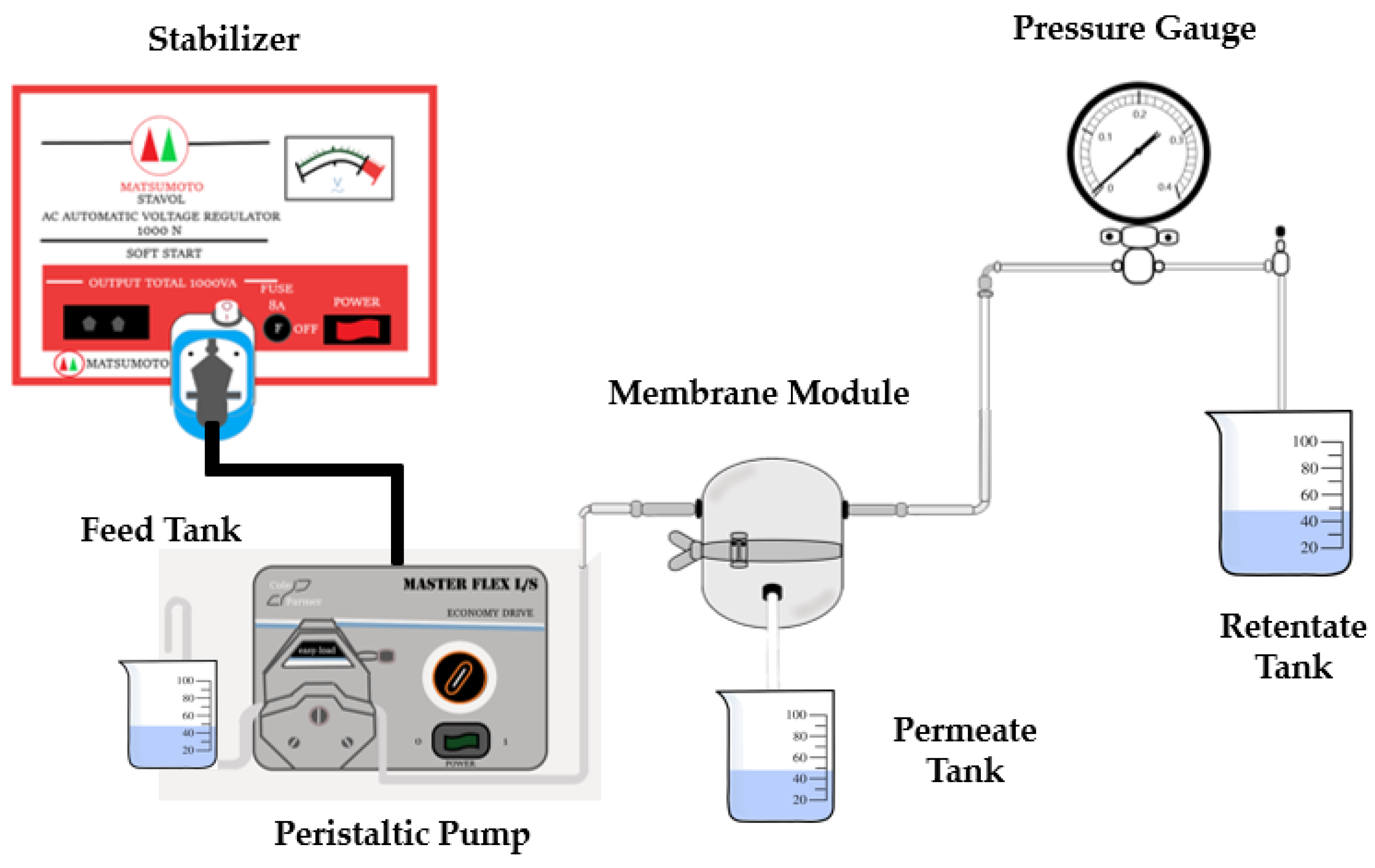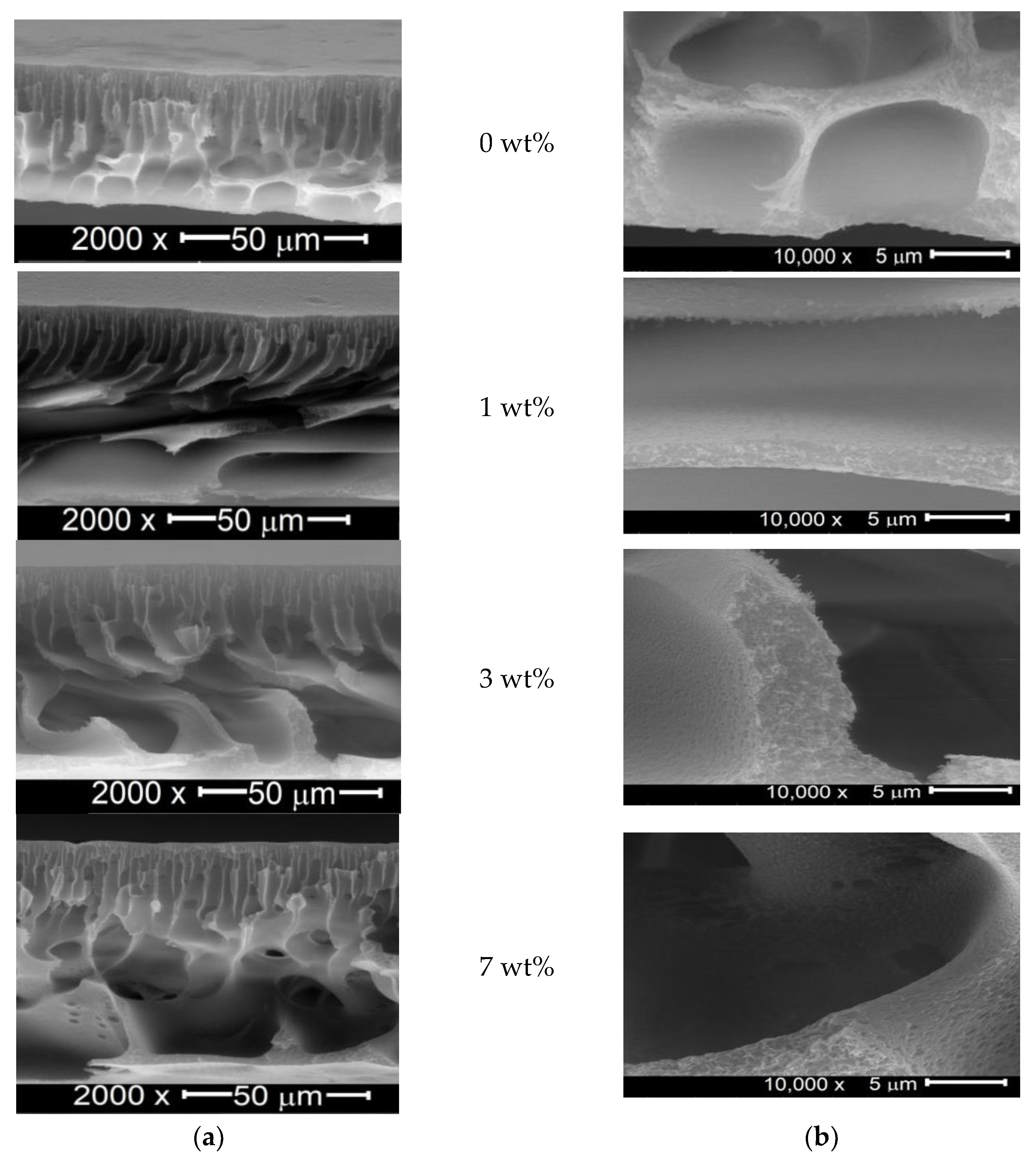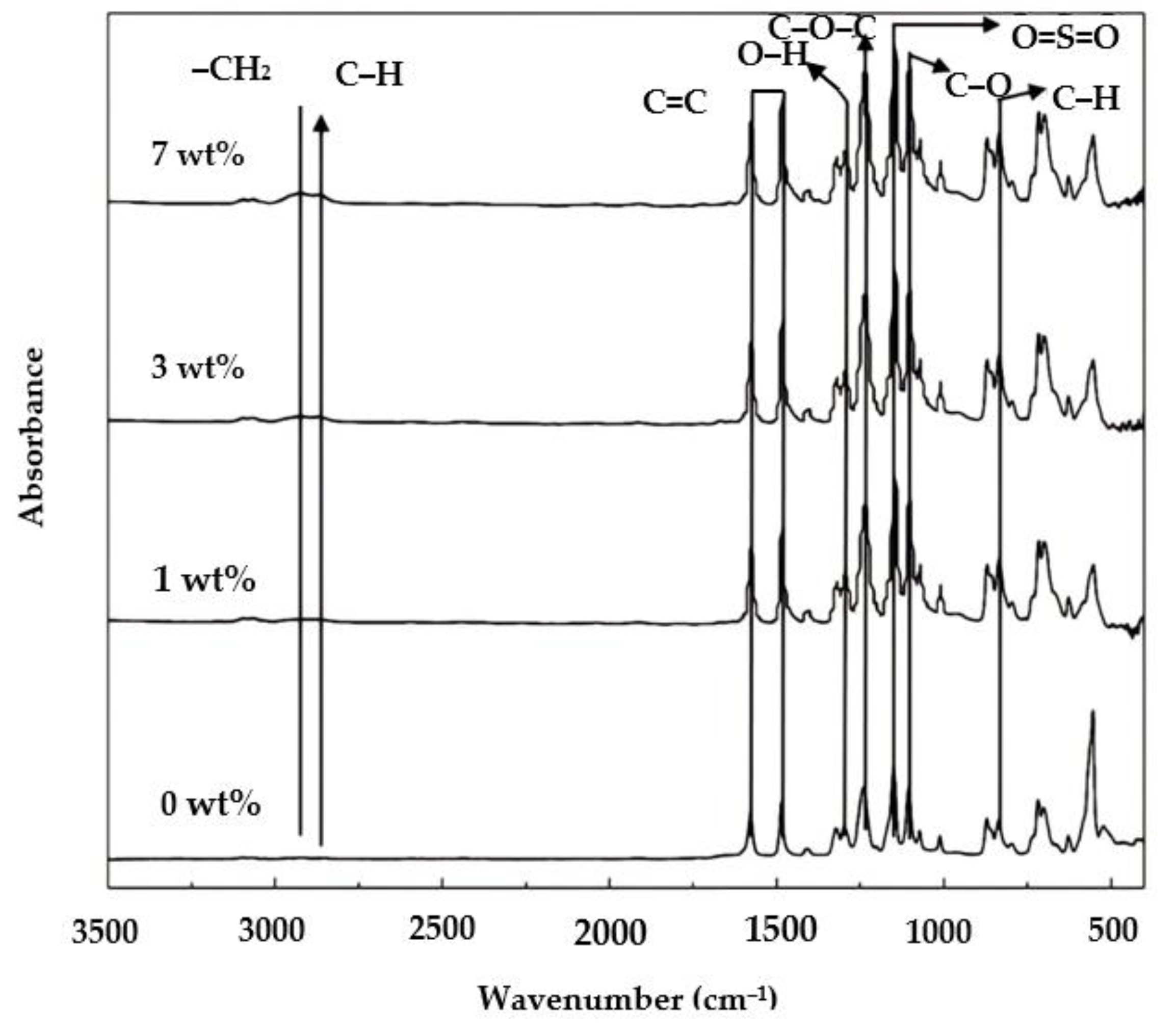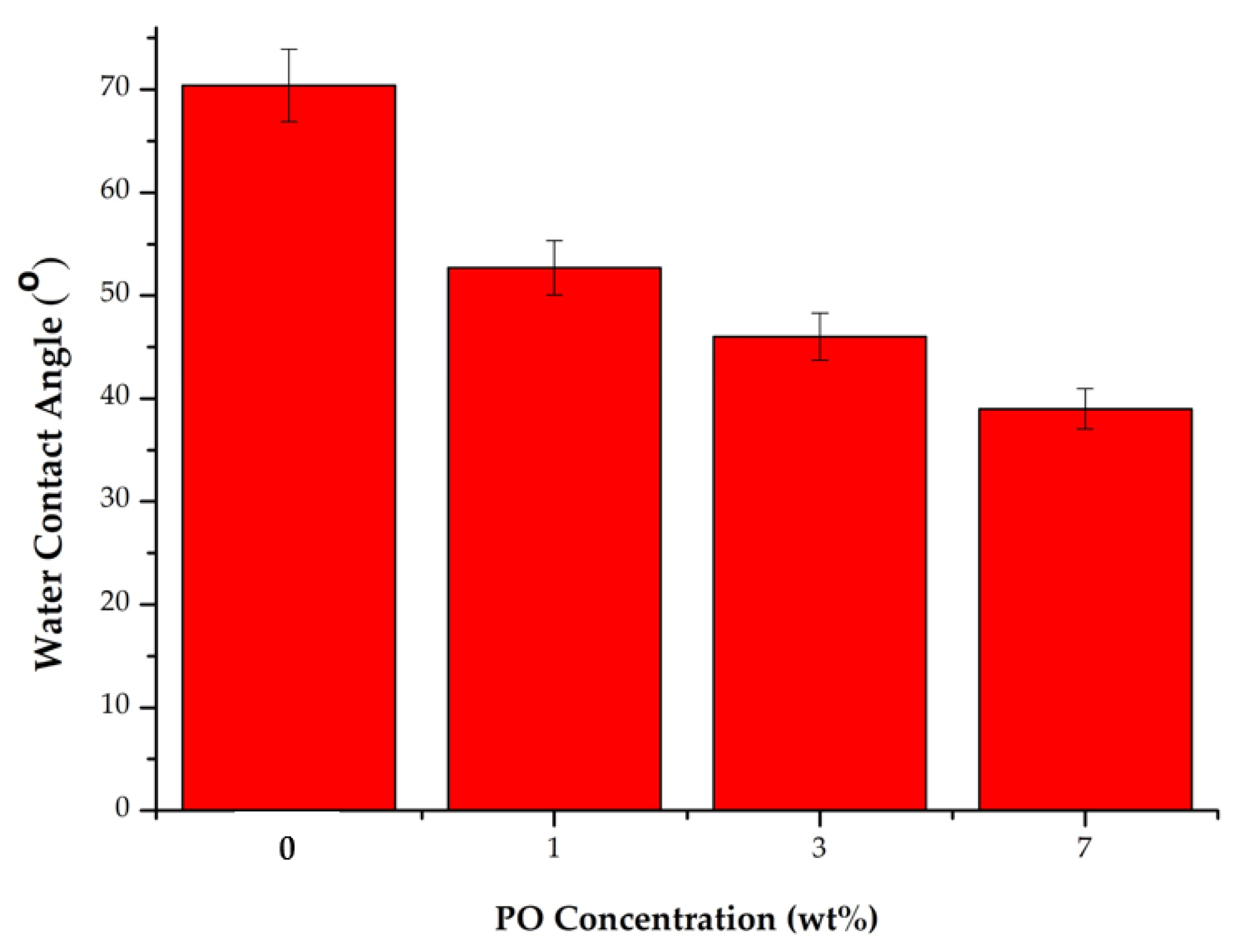Hydrophilic Antimicrobial Polyethersulfone Membrane for Removal of Turbidity of Well-Water
Abstract
:1. Introduction
2. Materials and Method
2.1. Materials
2.2. Synthesis of Membrane
2.3. Morphological Structure and Surface Elements Analysis
2.4. Functional Group Analysis
2.5. Hydrophicility Analysis
2.6. Membrane Porosity
2.7. Clean Water Flux and Rejection Test
2.8. Antibacterial Test
3. Results and Discussion
3.1. Membrane Structure and Morphology
3.2. Functional Groups of Membrane
3.3. Membrane Porosity
3.4. Membrane Hydrophilicity
3.5. Antibacterial Properties
3.6. Membrane Filtration Performance
4. Conclusions
Author Contributions
Funding
Data Availability Statement
Acknowledgments
Conflicts of Interest
References
- Gutierrez-Urbano, I.; Villen-Guzman, M.; Perez-Recuerda, R.; Rodriguez-Maroto, J.M. Removal of Polycyclic Aromatic Hydrocarbons (PAHs) in Conventional Drinking Water Treatment Processes. J. Contam. Hydrol. 2021, 243, 103888. [Google Scholar] [CrossRef] [PubMed]
- Choo, G.; Oh, J.E. Seasonal Occurrence and Removal of Organophosphate Esters in Conventional and Advanced Drinking Water Treatment Plants. Water Res. 2020, 186, 116359. [Google Scholar] [CrossRef] [PubMed]
- He, H.; Li, T.; He, C.; Chen, J.; Chu, H.; Dong, B. Removal of Natural Organic Matter in Full-Scale Conventional and Advanced Water Treatment Plants: Assimilable Organic Carbon and Its Precursors. Chem. Eng. J. Adv. 2021, 8, 100183. [Google Scholar] [CrossRef]
- Chang, H.; Zhu, Y.; Yu, H.; Qu, F.; Zhou, Z.; Li, X.; Yang, Y.; Tang, X.; Liang, H. Long-Term Operation of Ultrafiltration Membrane in Full-Scale Drinking Water Treatment Plants in China: Characteristics of Membrane Performance. Desalination 2022, 543, 116122. [Google Scholar] [CrossRef]
- Qiu, Z.; Chen, J.; Dai, R.; Wang, Z. Modification of Ultrafiltration Membrane with Antibacterial Agent Intercalated Layered Nanosheets: Toward Superior Antibiofouling Performance for Water Treatment. Water Res. 2022, 219, 118539. [Google Scholar] [CrossRef] [PubMed]
- Zhang, T.; He, Z.-H.; Wang, K.-P.; Wang, X.-M.; Xie, Y.-F.F.; Hou, L. Loose Nanofiltration Membranes for Selective Rejection of Natural Organic Matter and Mineral Salts in Drinking Water Treatment. J. Memb. Sci. 2022, 662, 120970. [Google Scholar] [CrossRef]
- Jebur, M.; Chiao, Y.H.; Thomas, K.; Patra, T.; Cao, Y.; Lee, K.; Gleason, N.; Qian, X.; Hu, Y.; Malmali, M.; et al. Combined Electrocoagulation-Microfiltration-Membrane Distillation for Treatment of Hydraulic Fracturing Produced Water. Desalination 2021, 500, 114886. [Google Scholar] [CrossRef]
- Purnima, M.; Paul, T.; Pakshirajan, K.; Pugazhenthi, G. Onshore Oilfield Produced Water Treatment by Hybrid Microfiltration-Biological Process Using Kaolin Based Ceramic Membrane and Oleaginous Rhodococcus opacus. Chem. Eng. J. 2023, 453, 139850. [Google Scholar] [CrossRef]
- Mulyati, S.; Muchtar, S.; Arahman, N.; Syamsuddin, Y.; Mat Nawi, N.I.; Harun, N.Y.; Bilad, M.R.; Firdaus, Y.; Takagi, R.; Matsuyama, H. Two-Step Dopamine-to-Polydopamine Modification of Polyethersulfone Ultrafiltration Membrane for Enhancing Anti-Fouling and Ultraviolet Resistant Properties. Polymers 2020, 12, 2051. [Google Scholar] [CrossRef]
- Muchtar, S.; Wahab, M.Y.; Fang, L.F.; Jeon, S.; Rajabzadeh, S.; Takagi, R.; Mulyati, S.; Arahman, N.; Riza, M.; Matsuyama, H. Polydopamine-Coated Poly(Vinylidene Fluoride) Membranes with High Ultraviolet Resistance and Antifouling Properties for a Photocatalytic Membrane Reactor. J. Appl. Polym. Sci. 2019, 136, 47312. [Google Scholar] [CrossRef]
- Aghapour Aktij, S.; Zirehpour, A.; Mollahosseini, A.; Taherzadeh, M.J.; Tiraferri, A.; Rahimpour, A. Feasibility of Membrane Processes for the Recovery and Purification of Bio-Based Volatile Fatty Acids: A Comprehensive Review. J. Ind. Eng. Chem. 2020, 81, 24–40. [Google Scholar] [CrossRef]
- Ekambaram, K.; Doraisamy, M. Surface Modification of PVDF Nanofiltration Membrane Using Carboxymethylchitosan-Zinc Oxide Bionanocomposite for the Removal of Inorganic Salts and Humic Acid. Colloids Surf. A Physicochem. Eng. Asp. 2017, 525, 49–63. [Google Scholar] [CrossRef]
- Guo, J.; Khan, S.; Cho, S.H.; Kim, J. ZnS Nanoparticles as New Additive for Polyethersulfone Membrane in Humic Acid Filtration. J. Ind. Eng. Chem. 2019, 79, 71–78. [Google Scholar] [CrossRef]
- Arahman, N.; Maruyama, T.; Sotani, T.; Matsuyama, H. Effect of Hypochlorite Treatment on Performance of Hollow Fiber Membrane Prepared from Polyethersulfone/N-Methyl-2-Pyrrolidone/Tetronic 1307 Solution. J. Appl. Polym. Sci. 2008, 110, 687–694. [Google Scholar] [CrossRef]
- Amiyati, D.R.; Indarti, D.; Muflihah, Y.M. Pengaruh Variasi Waktu Penguapan Terhadap Kinerja Membran Selulosa Asetat Pada Proses Ultrafiltrasi. Berk. Sainstek 2017, 5, 7. [Google Scholar] [CrossRef] [Green Version]
- Nasrollahi, N.; Aber, S.; Vatanpour, V.; Mahmoodi, N.M. Development of Hydrophilic Microporous PES Ultrafiltration Membrane Containing CuO Nanoparticles with Improved Antifouling and Separation Performance. Mater. Chem. Phys. 2019, 222, 338–350. [Google Scholar] [CrossRef]
- Safarpour, M.; Vatanpour, V.; Khataee, A. Preparation and Characterization of Graphene Oxide/TiO2 Blended PES Nanofiltration Membrane with Improved Antifouling and Separation Performance. Desalination 2016, 393, 65–78. [Google Scholar] [CrossRef]
- Bae, J.; Baek, I.; Choi, H. Mechanically Enhanced PES Electrospun Nanofiber Membranes (ENMs) for Microfiltration: The Effects of ENM Properties on Membrane Performance. Water Res. 2016, 105, 406–412. [Google Scholar] [CrossRef]
- Kourde-Hanafi, Y.; Loulergue, P.; Szymczyk, A.; Van der Bruggen, B.; Nachtnebel, M.; Rabiller-Baudry, M.; Audic, J.L.; Pölt, P.; Baddari, K. Influence of PVP Content on Degradation of PES/PVP Membranes: Insights from Characterization of Membranes with Controlled Composition. J. Memb. Sci. 2017, 533, 261–269. [Google Scholar] [CrossRef]
- Supriyadi, J.; Hakika, D.C.; Kusworo, T.D. Peningkatan kinerja membran selulosa asetat untuk pengolahan air payau dengan modifikasi penambahan aditif dan pemanasan. J. Tekonologi Kim. Ind. 2013, 2, 96–108. [Google Scholar]
- Bahremand, A.H.; Mousavi, S.M.; Ahmadpour, A.; Taherian, M. Biodegradable Blend Membranes of Poly(Butylene Succinate)/Cellulose Acetate/Dextran: Preparation, Characterization and Performance. Carbohydr. Polym. 2017, 173, 497–507. [Google Scholar] [CrossRef]
- Fernandes, A.V.; Pydi, C.R.; Verma, R.; Jose, J.; Kumar, L. Design, Preparation and in Vitro Characterizations of Fluconazole Loaded Nanostructured Lipid Carriers. Braz. J. Pharm. Sci. 2020, 56, 1–14. [Google Scholar] [CrossRef]
- Heptiana, E. Analisis Komparasi Tempat Tumbuh dan Jenis Alat Suling Terhadap Rendemen dan Mutu Minyak Nilam (Pogestemon cablin Benth.). SYLVA 2019, 8, 46–52. [Google Scholar] [CrossRef]
- Widowati, R.; Handayani, S.; Lasdi, I. Aktivitas antibakteri minyak nilam (Pogostemon cablin) terhadap beberapa spesies bakteri uji. Pro-Life 2019, 6, 244. [Google Scholar]
- Adhayani, L.; Ramadhani, R.; Ristianti, R. Kapasitas Daya Hambat Antibakteri Minyak Atsiri Nilam Aceh (Pogostemon cablin Benth.) Terhadap Methicillin-Resistant Staphylococcus Aureus (MRSA). PHARMACY J. Farm. Indones. (Pharm. J. Indones.) 2021, 18, 130. [Google Scholar] [CrossRef]
- Sari, M.; Tamrin; Kaban, J.; Alfian, Z. A Novel Composite Membrane Pectin from Cyclea Barbata Miers Blend with Chitosan for Accelerated Wound Healing. Polym. Test 2021, 99, 107207. [Google Scholar] [CrossRef]
- Arahman, N.; Rosnelly, C.M.; Windana, D.S.; Fahrina, A.; Silmina, S.; Maimun, T.; Mulyati, S.; Fathanah, U.; Aprilia, S.; Bilad, M.R.; et al. Antimicrobial Hydrophilic Membrane Formed by Incorporation of Polymeric Surfactant and Patchouli Oil. Polymers 2021, 13, 3872. [Google Scholar] [CrossRef] [PubMed]
- Mokarizadeh, H.; Raisi, A. Industrial Wastewater Treatment Using PES UF Membranes Containing Hydrophilic Additives: Experimental and Modeling of Fouling Mechanism. Environ. Technol. Innov. 2021, 23, 101701. [Google Scholar] [CrossRef]
- White, J.L. Interpretation of Infrared Spectra of Soil Minerals. Soil Sci. 1971, 112, 22–31. [Google Scholar] [CrossRef]
- Fahmi, Z.; Mudasir, M.; Rohman, A. Attenuated Total Reflectance-FTIR Spectra Combined with Multivariate Calibration and Discrimination Analysis for Analysis of Patchouli Oil Adulteration. Indones. J. Chem. 2020, 20, 1–8. [Google Scholar] [CrossRef]
- Koyuncu, I.; Yavuzturk Gul, B.; Esmaeili, M.S.; Pekgenc, E.; Orhun Teber, O.; Tuncay, G.; Karimi, H.; Parvaz, S.; Maleki, A.; Vatanpour, V. Modification of PVDF Membranes by Incorporation Fe3O4@Xanthan Gum to Improve Anti-Fouling, Anti-Bacterial, and Separation Performance. J. Environ. Chem. Eng. 2022, 10, 107784. [Google Scholar] [CrossRef]
- Fahrina, A.; Arahman, N.; Aprilia, S.; Bilad, M.R.; Silmina, S.; Sari, W.P.; Sari, I.M.; Gunawan, P.; Pasaoglu, M.E.; Vatanpour, V.; et al. Functionalization of PEG-AgNPs Hybrid Material to Alleviate Biofouling Tendency of Polyethersulfone Membrane. Polymers 2022, 14, 1908. [Google Scholar] [CrossRef] [PubMed]
- Sadrzadeh, M.; Bhattacharjee, S. Rational Design of Phase Inversion Membranes by Tailoring Thermodynamics and Kinetics of Casting Solution Using Polymer Additives. J. Memb. Sci. 2013, 441, 31–44. [Google Scholar] [CrossRef]
- Fathanah, U.; Meilina, H. Karakterisasi Dan Kinerja Membran Polyethersulfone Termodifikasi Aditif Anorganik secara Blending Polimer. J. Serambi Eng. 2021, 6, 2407–2414. [Google Scholar] [CrossRef]
- Wenten, I.G.; Khoiruddin, K.; Wardani, A.K.; Aryanti, P.T.P.; Astuti, D.I.; Komaladewi, A.A.I.A.S. Preparation of Antifouling Polypropylene/ZnO Composite Hollow Fiber Membrane by Dip-Coating Method for Peat Water Treatment. J. Water Process Eng. 2020, 34, 101158. [Google Scholar] [CrossRef]
- Le, A.N.M.; Tran, N.M.P.; Phan, T.B.; Tran, P.A.; Tran, L.D.; Nguyen, T.H. Poloxamer Additive as Luminal Surface Modification to Modulate Wettability and Bioactivities of Small-Diameter Polyurethane/Polycaprolactone Electrospun Hollow Tube for Vascular Prosthesis Applications. Mater. Today Commun. 2021, 26, 101771. [Google Scholar] [CrossRef]
- Srivastava, S.; Lal, R.K.; Singh, V.R.; Rout, P.K.; Padalia, R.C.; Yadav, A.K.; Bawitlung, L.; Bhatt, D.; Maurya, A.K.; Pal, A.; et al. Chemical Investigation and Biological Activities of Patchouli (Pogostemon cablin (Blanco) Benth) Essential Oil. Ind. Crops Prod. 2022, 188, 115504. [Google Scholar] [CrossRef]
- Lukitawesa; Safarudin, A.; Millati, R.; Taherzadeh, M.J.; Niklasson, C. Inhibition of Patchouli Oil for Anaerobic Digestion and Enhancement in Methane Production Using Reverse Membrane Bioreactors. Renew. Energy 2018, 129, 748–753. [Google Scholar] [CrossRef]
- Jin, P.; Yuan, S.; Zhang, G.; Zhu, J.; Zheng, J.; Luis, P.; van der Bruggen, B. Polyarylene Thioether Sulfone/Sulfonated Sulfone Nanofiltration Membrane with Enhancement of Rejection and Permeability via Molecular Design☆. J. Memb. Sci. 2020, 608, 118241. [Google Scholar] [CrossRef]
- Fahrina, A.; Yusuf, M.; Muchtar, S.; Fitriani, F.; Mulyati, S.; Aprilia, S.; Rosnelly, C.M.; Bilad, M.R.; Ismail, A.F.; Takagi, R.; et al. Development of Anti-Microbial Polyvinylidene Fluoride (PVDF) Membrane Using Bio-Based Ginger Extract-Silica Nanoparticles (GE-SiNPs) for Bovine Serum Albumin (BSA) Filtration. J. Taiwan Inst. Chem. Eng. 2021, 123, 323–331. [Google Scholar] [CrossRef]
- Wang, S.Y.; Rolly Gonzales, R.; Zhang, P.; Istirokhatun, T.; Takagi, R.; Motoyama, A.; Fang, L.F.; Matsuyama, H. Surface Charge Control of Poly(Methyl Methacrylate-Co-Dimethyl Aminoethyl Methacrylate)-Based Membrane for Improved Fouling Resistance. Sep. Purif. Technol. 2021, 279, 119778. [Google Scholar] [CrossRef]
- Park, W.-I.; Jeong, S.; Im, S.-J.; Jang, A. High Turbidity Water Treatment by Ceramic Microfiltration Membrane: Fouling Identification and Process Optimization. Environ. Technol. Innov. 2020, 17, 100578. [Google Scholar] [CrossRef]







| Sample | Turbidity of Raw Water (FNU) | Turbidity Rejection after Filtration with Membrane Samples (%) | |||
|---|---|---|---|---|---|
| 0 wt% PO | 1 wt% PO | 3 wt% PO | 7 wt% PO | ||
| 1. | 3.54 | 88 | 78 | 96 | 100 |
| 2. | 3.41 | 87 | 100 | 100 | 100 |
| 3. | 2.99 | 83 | 99 | 100 | 100 |
| 4. | 2.53 | 88 | 97 | 98 | 100 |
| 5. | 1.89 | 89 | 89 | 89 | 98 |
| 6. | 2.67 | 88 | 95 | 98 | 100 |
| 7. | 12.22 | 99 | 99 | 100 | 100 |
| 8. | 5.81 | 89 | 93 | 99 | 100 |
| 9. | 9.99 | 90 | 99 | 100 | 100 |
| 10. | 0.92 | 90 | 100 | 100 | 100 |
Publisher’s Note: MDPI stays neutral with regard to jurisdictional claims in published maps and institutional affiliations. |
© 2022 by the authors. Licensee MDPI, Basel, Switzerland. This article is an open access article distributed under the terms and conditions of the Creative Commons Attribution (CC BY) license (https://creativecommons.org/licenses/by/4.0/).
Share and Cite
Arahman, N.; Jakfar, J.; Dzulhijjah, W.A.; Halimah, N.; Silmina, S.; Aulia, M.P.; Fahrina, A.; Bilad, M.R. Hydrophilic Antimicrobial Polyethersulfone Membrane for Removal of Turbidity of Well-Water. Water 2022, 14, 3769. https://doi.org/10.3390/w14223769
Arahman N, Jakfar J, Dzulhijjah WA, Halimah N, Silmina S, Aulia MP, Fahrina A, Bilad MR. Hydrophilic Antimicrobial Polyethersulfone Membrane for Removal of Turbidity of Well-Water. Water. 2022; 14(22):3769. https://doi.org/10.3390/w14223769
Chicago/Turabian StyleArahman, Nasrul, Jakfar Jakfar, Wafiq Alni Dzulhijjah, Nur Halimah, Silmina Silmina, Muhammad Prayogie Aulia, Afrillia Fahrina, and Muhammad Roil Bilad. 2022. "Hydrophilic Antimicrobial Polyethersulfone Membrane for Removal of Turbidity of Well-Water" Water 14, no. 22: 3769. https://doi.org/10.3390/w14223769









